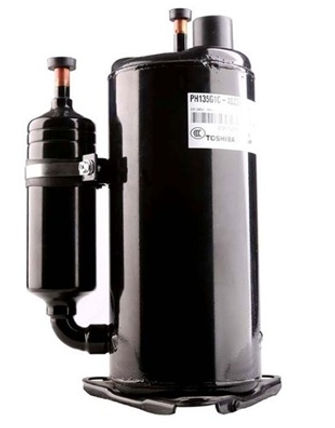

Compressor Types
Chapter 3 Page 1
Compressors
Download PDF Chapter questions
Refrigerators when they were first came out were mainly manufactured with one type of compressor "Reciprocating"
Types of Compressors Used in Appliances
-
Standard Reciprocating
-
Variable Capacity Compressor "VCC"
-
Linear Compressor
-
Rotary Compressor
A Standard Reciprocating Compressor uses a motor similar to a dryer motor it only travels in one direction and at only one speed. The electric motor drives a piston which on its downward stroke pulls the low pressure vapor refrigerant from the evaporator through the suction line. The top of the compressor contains two reed valves. One for the suction which opens when the piston travels down and the second discharge valve closes. On the upward stroke of the piston the suction valve closes and the discharge valve opens allowing the high pressure vapor refrigerant to pass through the discharge line of the compressor.
Crankshaft of compressor rotating and connecting rod going up and down with the piston on top.


Standard Compressors and VCC compressors are mechanically the same, the difference is the windings in the motor. A standard compressor one speed and one direction. VCC Compressor has a different set of windings that allow one direction but can vary the speed based on the demand for cooling. When the refrigerator is warm like after shopping and loading groceries the compressor will run at max speed - and it gets closer to the set temperature the compressor slows down.
Linear Compressor

Reciprocating Compressor
Linear Compressor
The linear compressor is totally different from a standard or VCC compressor - The standard compressor rotates a shaft in the middle similar to a locomotive train. Where the Linear compressor uses something similar to a solenoid when it is energized it pulls the piston down and forces the refrigerant into the compression chamber through a valve located on the top of the piston, then the solenoid is deenergized and springs force the piston upward chaining the Low pressure vapor into High pressure vapor. The other main difference beside the mechanical action of the piston is the valves instead of located on top of the compression chamber, they are actually part of the piston. The is usually where most of these compressors fail as the valve takes a tremendous beating. This can cause metal fatigue and cracking of the valves themselves. When these valves fail the compressor usually continues to operate, but there is little to no compression. Meaning when gauges are put on the machine the low pressure side is usually higher than normal and the high pressure side is lower than normal. This is called an inefficient compressor. See image below showing a cracked valve on top of the linear piston.


Rotary Compressor
Rotary compressors are seldomly used on refrigerators, but can be found on some wall and window unit air conditioners. The motor windings are the same as a standard compressor with both a strat and run winding. Its difference is the mechanical component. This compressor does not use a piston

Rotary compressors have a set of rotating vanes that are closely fitted into an eccentric cylinder. The vanes or blades push the refrigerant vapor around ahead of them into a narrowing area of the eccentric cylinder, compressing the vapor and forcing it into the high side of the system. Refrigerant vapor flows from the low side into the void behind the moving blades.
The overall efficiency of a rotary compressor is higher than that of the reciprocating type. Rotary compressors are also more compact and can produce a deeper vacuum than a reciprocating compressor. It is for this reason that a rotary compressor is used as a vacuum pump for evacuating a refrigeration system for servicing. However, a reciprocating compressor can handle larger volumes of refrigerant. Oil within the rotary compressor not only lubricates the moving parts, but it also serves to cool
SUMMARY
The low-pressure side of a refrigeration system contains the low-pressure and low-temperature refrigerant and consists of the evaporator and suction line.
The dome is under low pressure in a reciprocating compressor.
The dome is under high pressure in a rotary compressor.
A condenser dissipates heat contained in the refrigrant and changes it from a gas to a liquid.
A capillary tube is a metering device that regulates the amount of refrigerant flow in a refrigeration system.
An evaporator absorbs heat from the desired area and changes the liquid refrigerant to a gas.
A drier-strainer removes moisture and impurities from a refrigeration system.
An accumulator prevents liquid refrigerant from entering the compressor and causing damage.
A precooler is used to condense oil vapor to a liquid and return it to the compressor.
An oil cooler is used with some Tecumseh compressors to cool the discharge gas and pass it back through a loop of tubing in the compressor below the oil level. The pre-cooled gas absorbs heat and cools the oil.
Follow the link to take the Chapter 3 exam - TMM Sealed System Chapter 3 Test